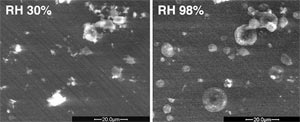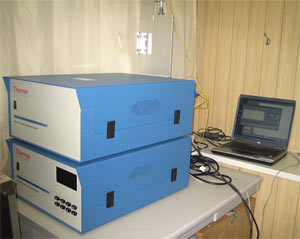
Figure 1 Formation of water droplets in ESEM chamber
【気象・気候における大気エアロゾルの役割】
大気中の微小粒子は、太陽光の散乱や雲形成などを通じて気象および気候に影響を及ぼすが、その程度は粒子の種類によって異なる。様々な環境で採取された粒子の物理的・化学的特性を、主に電子顕微鏡を用いて調べている。環境制御型電子顕微鏡 (ESEM) を用いた水蒸気の凝縮実験 (Figure 1) を行い、混合粒子の湿度特性を明らかにしようとしている。

Figure 1 Formation of water droplets in ESEM chamber
【九州の大気環境】
春季における九州の大気環境は、大陸からの気塊の影響を強く受ける。長距離にわたる黄砂、大気汚染物質、微生物の移動を把握する目的で、熊本および長崎 (福江島) において大気エアロゾルのサンプリング、モニタリングを行っている (Figure 2)。

Figure 2 Facility for monitoring atmospheric sulfate particles placed in Fukuejima
Roles of atmospheric aerosols in weather and climate : Airborne particles affect weather and climate through scattering of sunlight, cloud formation, and so on. The extent depends on characteristics of the particles. We investigate physical and chemical properties of atmospheric aerosol particles, including experiments using environmental scanning electron microscopy (ESEM) to clarify hygroscopicity of internally mixed particles (Figure 1).
Atmospheric environment of the Kyushu area : Air masses from the Asian continent have significant impact on the atmosphere over the Kyushu area, especially in spring time. We perform sampling and monitoring of atmospheric aerosols in Kumamoto and Nagasaki (Fukuejima) to study the processes of long-range transport of dust, air pollutants, and bioaerosols, as well as the consequences of the transport.